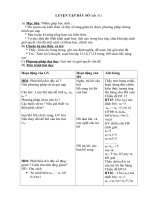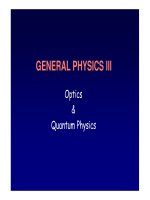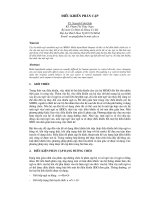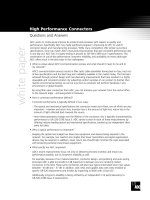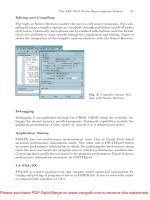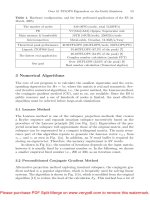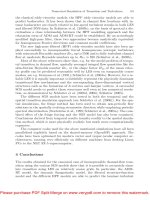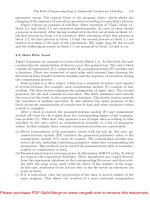Tài liệu High Performance Driver P5a pptx
Bạn đang xem bản rút gọn của tài liệu. Xem và tải ngay bản đầy đủ của tài liệu tại đây (77.13 KB, 7 trang )
HIGH PERFORMANCE DRIVES
---------------------------------------------------------------------------------------------------------------------------------------
E Levi, 2001
50
regarded as constant). Equations derived for the current-fed machine remain to be valid. Two co-
ordinate transformations are required: one transforms stator voltage d-q axis references into phase
voltage references, while the other one transforms measured phase currents into d-q axis components.
Hence the equations that are relevant for a voltage-fed rotor flux oriented induction machine are the
following:
vve vve
ds ds d qs qs q
*' *'
==++
eLi e
L
L
drsqs qr
s
m
r
=− =
ωσ ω ψ
ψ
ψ
rr
r
mds
T
d
dt
Li
+=
()
ω ω ψ
rrrmqs
TLi−=
TP
L
L
i
e
m
r
rqs
=
3
2
ψ
(3.18)
vv v
vv v
vv v
ads rqs r
bds r qs r
cds r qs r
** *
** *
** *
cos sin
cos( / ) sin( / )
cos( / ) sin( / )
=−
=−−−
=−−−
φφ
φπ φπ
φπ φπ
23 23
43 43
iii i
iii i
ds a r b r c r
qs a r b r c r
=+−+−
=− + − + −
( / )( cos cos( / ) cos( / ))
( / )( sin sin( / ) sin( / ))
23 23 43
23 23 43
φ φ π φ π
φφπ φπ
It should be noted that the control system in both the voltage fed and current fed drive processes DC
quantities (see discussion in Sub-section 2.4.1.) and that it fully corresponds to the one met in DC
machines. The principal difference is the need for co-ordinate transformation in the case of an induction
machine.
3.3. ESTIMATION OF MAGNITUDE AND POSITION OF ROTOR FLUX SPACE VECTOR
3.3.1. Methods for direct rotor flux oriented control
If the decoupled flux and torque control is to be achieved, it is absolutely necessary to know
instantaneous position of the rotor flux space vector, because the stator current space vector has to be
orientated with respect to the rotor flux space vector. Estimation method suggested at the earliest stage
of vector control development applies convenient induction machine model and measured values of
stator currents and air gap flux (main, magnetising flux). Hall sensors are utilised for assessment of
main flux components. Stator phase currents are measured and converted into alfa-beta components
using (2.27),
iiii
iii
sabc
sbc
α
β
=−−
=− − +
(/)( . . )
(/)( / /)
2 3 05 05
23 32 32
(3.19)
while Hall sensors directly provide main flux components in the stationary reference frame,
ψ ψ
αβ
mm
,
(two fixed sensors are used in the air-gap of the machine, displaced by 90 degrees). Magnitude and
HIGH PERFORMANCE DRIVES
---------------------------------------------------------------------------------------------------------------------------------------
E Levi, 2001
51
position of the rotor flux space vector can then be obtained from flux linkage equations (2.21), taking
into account that
ψ ψ
αα ββ
ααα βββ
mmm mmm
msr msr
Li Li
iii iii
==
=+ =+
(3.20)
and that
ψ ψ ψ
ψψ ψ
αγαα γαα α
βγββ γββ β
rrrmrms m
rrrmrms m
Li L i i
Li L i i
=+= −+
=+= −+
()
()
(3.21)
according to the following equations
ψ σ ψ ψ σ ψ
ψψψ ϕψψ ϕψψ
α α γα β β γβ
αβ α β
rrmrs rrmrs
rrr rrr rrr
Li Li=+ − =+ −
=+ = =
() ()
cos sin
11
22
(3.22)
where
σ
γ
rrm
LL=
/.
Torque (2.19) can be given as a function of the measured variables,
()
TPi i
emsms
=−
3
2
ψψ
αβ βα
(3.23)
Calculation of magnitude and position of the rotor flux space vector using the measured stator currents
and air gap flux is illustrated in Fig. 3.7 (output related to the rotor flux position is given as ‘cos’ and
‘sin’ function of this angle; note that that is exactly the form required by the co-ordinate transformation
block
exp( )
j
r
φ
). This estimation procedure will be called
ψ
m s
i−
estimation further on.
ψ
α
m
ψ
α
r
1+
σ
r
−ψ
r
ψ
β
m
ψ
β
r
1+
σ
r
−
cos
φ
r
i
a
3L
γ
r
i
b
sin
φ
r
i
c
2L
γ
r
Fig. 3.7 - Calculation of rotor flux space vector from sensed stator currents and main flux.
An important feature of the
ψ
ms
i−
estimator is that acquisition of rotor speed or position signal is not
needed for the estimation procedure. This enables realisation of a cheaper drive with still very good
quality of dynamic response. Due to the numerous shortcomings experienced in application of Hall
sensors for flux measurement this method of rotor flux position estimation is of historical rather than
practical value.
The second rotor flux space vector estimation method asks for measurement of stator voltages and
stator currents. If the stator phase currents and voltages are sensed and transformed into two-phase
stationary reference frame, magnitude and position of the rotor flux space vector can be calculated
either by means of analogue or digital circuitry. Model of an induction machine in stationary reference
frame, (2.24)-(2.26), together with flux linkage equations (2.21), suggests the following procedure:
HIGH PERFORMANCE DRIVES
---------------------------------------------------------------------------------------------------------------------------------------
E Levi, 2001
52
iiii
iii
sabc
sbc
α
β
=−−
=− − +
(/)( . . )
(/)( / /)
2 3 05 05
23 32 32
(3.19)
vvvv
vvv
sabc
sbc
α
β
=−−
=− − +
(/)( . . )
(/)( / /)
2 3 05 05
23 32 32
(3.24)
()
()
ψ
ψ
ααα
βββ
ssss
ssss
vRidt
vRidt
=−
=−
ò
ò
(3.25)
ψσψσ
ψσψσ
ααα
βββ
rrs
sr
m
s
rrs
sr
m
s
LL
L
i
LL
L
i
=+ −
=+ −
()
()
1
1
(3.26)
ψψψ ϕψψ ϕψψ
αβ α β
rrr rr rr
=+ = =
22
cos sin
rr
//
Equation for torque calculation (3.23) remains unchanged,
()
TPi i
emsms
=−
3
2
ψψ
αβ βα
(3.23)
Block diagram of the estimator which relies on sensed stator currents and voltages,
vi
ss
−
estimator, is
showninFig.3.8.
The most pronounced shortcoming of the
v i
s s
−
method is that integration is involved, according to
(3.25). This restricts practical implementations of the estimator to drives which are not aimed for
operation at zero speed. Typical limit is frequency value of 3 Hz. Comparative analysis of
v i
s s
−
and
ψ
ms
i−
estimators reveals that their behaviour is practically identical at frequencies above 10 Hz, while
at lower frequencies
ψ
m s
i−
estimator is advantageous and can be used down to the frequency of 0.5
Hz. Typical applications of
vi
ss
−
estimatorarecorrelatedtodriveswherespeedandpositionsensors
are to be avoided. It should be noted that
v i
s s
−
estimator does not necessarily ask for voltage
measurement, because the output voltages of a transistor inverter can be reconstructed from the driving
signals of power semiconductor switches and measured DC link voltage.
3v
α
s
ψ
α
r
ψ
r
v
a
ò
1+σ
r
v
b
v
β
s
−−ψ
β
r
ò
1+σ
r
v
c
2
−−
R
s
R
s
cos
φ
r
i
α
s
i
a
3
σ
L
s
L
r
/L
m
i
b
i
c
2 σL
s
L
r
/L
m
sinφ
r
i
β
s
Fig. 3.8 - Rotor flux space vector estimation process involving measured stator currents and voltages.
HIGH PERFORMANCE DRIVES
---------------------------------------------------------------------------------------------------------------------------------------
E Levi, 2001
53
The most frequently utilised method of rotor flux space vector estimation asks for measurement of
stator currents and rotor speed or position (it will be denoted as
i
s
−
ω
estimator). The main reasons
for such a widespread application of this scheme are that there is no need for special construction or
modification of the machine, integration is avoided and estimation is operational at zero speed. It is
customarily used in the vector control system illustrated in Fig. 3.6, where current control is performed
in rotational reference frame and the machine is either treated as being voltage-fed, or it is assumed to
be current-fed and decoupling circuit is omitted. Current control in rotating co-ordinates normally leads
to fully digital realisation of the vector control, in contrast to the scheme shown in Figs. 3.3-3.4 where
current controllers operate in stationary frame of reference and realisation is usually combined
analogue-digital.
Estimation of rotor flux space vector by means of measured stator currents and rotor speed (position)
utilises model (3.9) of an induction machine in the rotor flux oriented reference frame. Consequently,
values of measured stator currents have to be transformed from stationary to rotational, rotor flux
oriented, reference frame using
iii i
iii i
ds a r b r c r
qs a r b r c r
=+−+−
=− + − + −
( / )( cos cos( / ) cos( / ))
( / )( sin sin( / ) sin( / ))
23 23 43
23 23 43
φ φ π φ π
φφπ φπ
(3.27)
Equations (3.9)
ψ
ψ
rr
r
mds
T
d
dt
Li+=
()
ω ω ψ
rrrmqs
TLi−=
(3.9)
TP
L
L
i
e
m
r
rqs
=
3
2
ψ
canberewrittenas
()
iT
d
dt
L
Li T
ds r r
r
m
sl m qs r r
=+
æ
è
ç
ö
ø
÷
=
ψ
ψ
ωψ
/
(3.28)
Spatial position of the rotor flux space vector is determined with
()
ϕωω
rsl
dt=+
ò
(3.29)
while torque estimation can be done by the aid of (3.9)
TP
L
L
i
e
m
r
rqs
=
3
2
ψ
(3.9)
The most frequent outlook of the estimator is given in upper part of the Fig. 3.9, where it is shown as an
integral part of the drive of Fig. 3.3. Superscript ‘e’ denotes all the quantities that are the estimates of
actual variables. There are some other realisations, with minor modifications which do not affect the
fundamental operating principles of the scheme.
Estimation of rotor flux space vector, out of the measured stator currents and rotor speed, can be
performed in stationary reference frame as well. In this case there is no need for transformation of
measured currents from stationary to rotational reference frame. However, the equations that have to be
used are much more complicated and this method is rarely applied in practice. Furthermore, if current
controllers operate in rotational reference frame, Fig. 3.6, measured stator currents have to be
transformed from stationary to rotational reference frame anyway and it is far simpler to apply
estimator structure depicted in Fig. 3.9.
All the three estimators discussed so far are used for direct field orientation, since measured
electromagnetic variables are involved in the process of rotor flux position calculation.
HIGH PERFORMANCE DRIVES
---------------------------------------------------------------------------------------------------------------------------------------
E Levi, 2001
54
ωω
T
r
L
m
1/(1+
sT
r
)
i
α
s
i
a
ω
sl
e
ψ
r
e
i
ds
e
2
−
j
φ
r
e
i
b
i
qs
e
e
i
β
s
i
c
L
m
3
ω
r
L
m
/
L
r
3
P
/2
1/
s
φ
r
e
T
e
e
_
φ
r
e
ω
*
T
e
*
i
qs
*
i
β
s
*
i
a
*
i
a
PI PI 2 C
_
j
φ
r
e
R
_
ψ
r
e
e
i
b
*
P
i
b
IM
Field
ψ
r
*
i
ds
*
i
α
s
*
3
i
c
*
W
i
c
weak M
ω
PI
Fig. 3.9 - Rotor flux space vector estimation by means of measured stator currents and rotor speed
(position).
3.3.2. Indirect (feed-forward) estimation of rotor flux position
Vector control can be achieved by indirect orientation as well, where position of rotor flux space vector
is estimated again on the grounds of induction machine model in rotor flux oriented reference frame. In
order to achieve orientation it is theoretically necessary to measure only rotor speed or position. Indirect
vector controlled induction machine is conventionally fed from current-regulated PWM inverter and
current control is performed in the stationary reference frame. Indirect orientation principle follows
directly from (3.9) and is described with
i
P
TL
L
i
L
T
d
dt
qs
e
r
r
m
ds
m
rr
r
*
*
*
**
*
=
=+
æ
è
ç
ç
ö
ø
÷
÷
2
3
1
ψ
ψ
ψ
(3.30)
ω
ψ
ϕωω
sl
m
r
qs
r
rsl
L
T
i
dt
*
*
*
*
()
=
=+
ò
(3.31)
Indirect method of calculating the rotor flux position is illustrated in Fig. 3.10, where asterisk denotes
once more reference quantities. Prevailing applications are for drives which require operation in the
base speed range only. Consequently, only operation in the constant flux region is needed and the
scheme can be further simplified. Such a drive is shown in Fig. 3.11, where due to
ψψ
rdsrm
const i L
***
., /==
is a constant as well. Torque command (or stator q-axis current command) is
obtained as output from the speed controller. Indirect vector control has gained enormous popularity in
practical realisations as the overall control system complexity is significantly reduced compared to
direct orientation methods.
